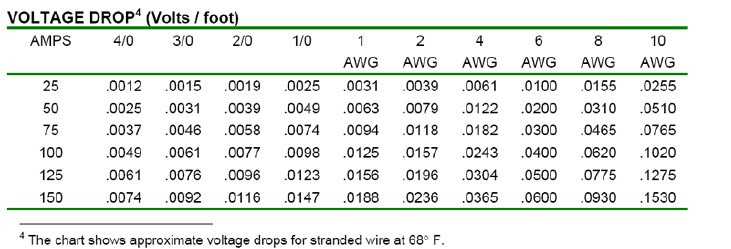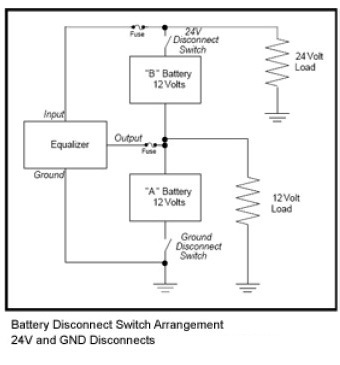How to Install a Battery Equalizer System
- Determining the proper equalizer size
- Selecting a mounting location
- Choosing the right wire gauge
- Wiring the equalizer system
- Post-installation maintenance
If you have a complex dual voltage (12/24V) system, it’s likely you can extend your battery life by adding a Battery Equalizer. We covered the ‘why’ of equalizer systems in a previous post, but here’s the short version:
Without a Battery Equalizer, your system is likely depleting one battery more than the other, and overcharging the one that isn’t being fully depleted. That leads to overheating and shorter battery life, over time. Battery Equalizers distribute the load across both batteries, for more uniform depletion and charging.
Read on for a step-by-step guide to installing a Battery Equalizer System.
1. Determine the Equalizer Size
Before you can choose the right size (output current) of Equalizer, you need to determine what your load requirements are. In general, the Equalizer should be able to handle at least 120% of the average load.
For example, if the 12V load is a fan motor with a constant draw of 10 amps, you would need a 12A amplifier.
In high temperature conditions, however, you may need to “de-rate” the Equalizer — that is, operate it at a lower output than it’s capable of providing, in order to keep the temperature within its operating range. In this case, you would need a higher-capacity Equalizer than simply 120% of the 12V load.
2. Select a Mounting Location
The amount of available space you have will likely limit the potential mounting locations for your Equalizer. Within that available space, however, keep these guidelines in mind:
- Mounting position: Mount the equalizer on a wall with the fins vertical, to maximize the amount of cool air that moves over the cooling fins. If a vertical mount isn’t possible, place it horizontally with the fins facing up. Avoid mounting with the fins pointed down, as this method of cooling is the least efficient.
- Airflow: Heat is the single most important factor in the reliability of electrical equipment. To better disperse heat, the mounting compartment should not be closed to outside air. Also avoid mounting the Equalizer where hot air will be directed onto it, this will counteract the cooling fins.
- Wire length: Select a mounting location that gives the shortest wire path to the battery. Long wires require more voltage than short ones, and the effects can be significant.
3. Choose the Right Wire Gauge
Wires with too much resistance will limit the amount of current to the battery, increasing the charging time and reducing the efficiency of the system. For the output wire, the maximum current should equal the equalizer rated output current. For input and ground wires, maximum current should be .6x the rated output current.
Be sure to include the voltage drop in your wire gauge selection. The voltage drop across any power wire should be no more than about .10V, maximum. Use this table to calculate the proper gauge of wire you should use for the length .
Voltage Drop for Wire:
Go to the entry on the left side of table 1 that corresponds to the maximum current that the wire will have to carry.
The table entries to the right correspond to the voltage drop (per foot) that will be seen, if used with the wire gauge shown at the top of the chart.

To find the total voltage drop for a specific gauge wire, multiply the length of wire required for the installation by the chart entry for that wire gauge.
Voltage Drop = Wire length (in feet) x chart entry
Example: The output wire in an Equalizer is required to carry 75 amps (Equalizer maximum output), and will
need to be 5 feet long. For best performance, we do not want the voltage drop to be any more than 0.10V when the current is 75 amps. From the chart, we see that #4 AWG wire has 0.0182V loss per foot. The total loss is: Voltage Drop (#4 AWG) = 5ft x 0.0182 V/ft. = 0.091V.
This is the best choice in terms of economy and performance. #6 AWG cannot be used, since the drop for it would be: Voltage Drop (#6 AWG) = 5ft x 0.0465 V/ft. = 0.150V, which is greater than desired.
4. Wire the Equalizer System
There are multiple ways to wire an Equalizer system, depending on which components you want to include. Here is a diagram for a standard, simple connection:

Make sure that the connection between the two batteries is a short, heavy-gauge wire, and to use fuses sized 25% above the current passing through the wire.
If you want to include a battery disconnect, you will need two switches. One should be between the “B” battery’s positive terminal and the Equalizer-alternator connection. The second can be either between the “A” battery negative terminal and ground:

You can also use an Equalizer to power a remote battery, such as on a trailer. The same rules apply as for the standard installation:
- Keep the wire runs as short as possible
- Size wires accordingly (see the sizing table above)
Keep these general guidelines in mind, regardless of how your system is wired:
- Crimp wire lugs for more reliable connections
- Use fuse circuit protection to protect your wiring
- Connect loads to the battery, not the Equalizer output
- Install a ground wire – never rely on the chassis for ground return
Don’t weld to the vehicle with the Equalizer connected
5. Maintain Your System
Before you power on the system, make sure that both batteries are fully charged. The high starting current can cause a discharged battery to reverse the voltage, and the reversed voltage can also be applied to power connections, potentially damaging your accessories. Sure Power Equalizers are protected against this type of reversal, but it’s still better to use caution.
To maintain your system, keep the cooling fins clear of mud, dust or debris, and monitor connections for:
- Overheated wires
- Discolored studs or nuts
- Low or no output
Battery Equalizer Systems are a simple way to protect the battery life of your 12/24V Dual Voltage Systems. They’re easy to install and maintain, and well worth the investment for all but the simplest Dual Voltage applications.
Click through to see Waytek’s collection of Sure Power Equalizers and Converters, from Eaton.
For more information about dual voltage systems, see the Waytek white paper Guide to Successful Dual Voltage Systems.
Subscribe Now
Subscribe and be the first to know when new articles are published.
